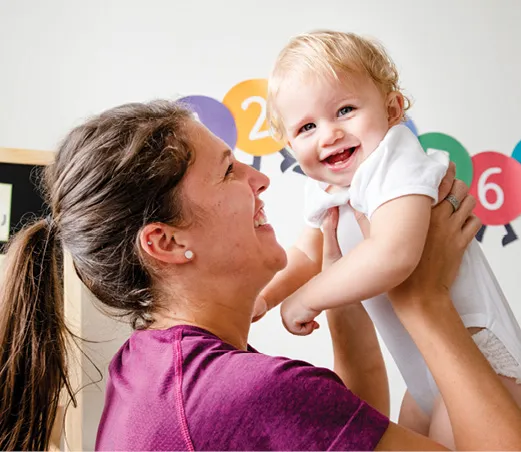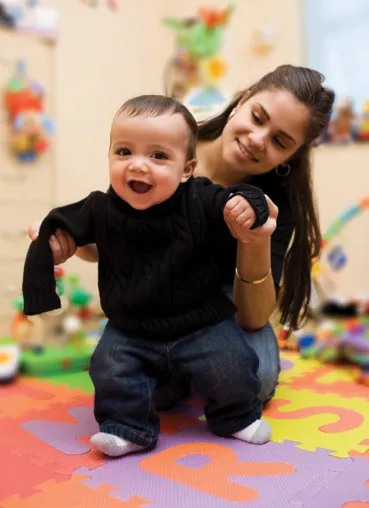
eBook - ePub
Day to Day the Relationship Way
Creating Responsive Programs for Infants and Toddlers
Donna S. Wittmer, Alice Sterling Honig
This is a test
Buch teilen
- English
- ePUB (handyfreundlich)
- Über iOS und Android verfügbar
eBook - ePub
Day to Day the Relationship Way
Creating Responsive Programs for Infants and Toddlers
Donna S. Wittmer, Alice Sterling Honig
Angaben zum Buch
Buchvorschau
Inhaltsverzeichnis
Quellenangaben
Über dieses Buch
Loving, Consistent Relationships Foster Learning
From their earliest moments, young children rely on their families and early childhood educators for the protection, affection, and emotional connections they need to thrive. This book discusses ways teachers can support children's development in all domains through daily relationship-based interactions and highlights the awe-inspiring capabilities of infants and toddlers to learn and love when nurtured through meaningful relationships.
Features include:
- A focus on emotional and social development as the foundation for learning
- Research that ties to everyday practice
- Engaging vignettes and examples that bring relationship-based program elements to life
- Links with NAEYC's Professional Standards and Competencies for Early Childhood Educators
With this practical, easy-to-read handbook, marvel at the wonder of infants' and toddlers' development and discover how to provide engaging learning experiences within the context of satisfying interactions.
Häufig gestellte Fragen
Wie kann ich mein Abo kündigen?
Gehe einfach zum Kontobereich in den Einstellungen und klicke auf „Abo kündigen“ – ganz einfach. Nachdem du gekündigt hast, bleibt deine Mitgliedschaft für den verbleibenden Abozeitraum, den du bereits bezahlt hast, aktiv. Mehr Informationen hier.
(Wie) Kann ich Bücher herunterladen?
Derzeit stehen all unsere auf Mobilgeräte reagierenden ePub-Bücher zum Download über die App zur Verfügung. Die meisten unserer PDFs stehen ebenfalls zum Download bereit; wir arbeiten daran, auch die übrigen PDFs zum Download anzubieten, bei denen dies aktuell noch nicht möglich ist. Weitere Informationen hier.
Welcher Unterschied besteht bei den Preisen zwischen den Aboplänen?
Mit beiden Aboplänen erhältst du vollen Zugang zur Bibliothek und allen Funktionen von Perlego. Die einzigen Unterschiede bestehen im Preis und dem Abozeitraum: Mit dem Jahresabo sparst du auf 12 Monate gerechnet im Vergleich zum Monatsabo rund 30 %.
Was ist Perlego?
Wir sind ein Online-Abodienst für Lehrbücher, bei dem du für weniger als den Preis eines einzelnen Buches pro Monat Zugang zu einer ganzen Online-Bibliothek erhältst. Mit über 1 Million Büchern zu über 1.000 verschiedenen Themen haben wir bestimmt alles, was du brauchst! Weitere Informationen hier.
Unterstützt Perlego Text-zu-Sprache?
Achte auf das Symbol zum Vorlesen in deinem nächsten Buch, um zu sehen, ob du es dir auch anhören kannst. Bei diesem Tool wird dir Text laut vorgelesen, wobei der Text beim Vorlesen auch grafisch hervorgehoben wird. Du kannst das Vorlesen jederzeit anhalten, beschleunigen und verlangsamen. Weitere Informationen hier.
Ist Day to Day the Relationship Way als Online-PDF/ePub verfügbar?
Ja, du hast Zugang zu Day to Day the Relationship Way von Donna S. Wittmer, Alice Sterling Honig im PDF- und/oder ePub-Format sowie zu anderen beliebten Büchern aus Bildung & Frühkindliche Bildung. Aus unserem Katalog stehen dir über 1 Million Bücher zur Verfügung.
Information
Thema
BildungPART 1
Meeting Young Children’s Needs Through Strong Relationships
At the heart of programs that effectively nurture infants’ and toddlers’ development and learning are relationships—relationships between children and families, children and teachers, peers, and families and teachers. Part 1 explores this important foundation. Chapter 1 emphasizes why relationships are so critical for young children’s health and well-being and how to develop these relationships during your daily interactions with children. In Chapter 2, you will discover ways to develop responsive relationships with children’s families and support children’s relationships with their families.
Chapter 1
Build Strong Relationships with Infants and Toddlers
Infants and toddlers in thriving relationships with special adults feel safe, protected, appreciated, and loved. When an infant establishes a relationship with a sensitive and responsive caregiver, the infant learns whom to trust and turn to when needing support (Howes & Spieker 2008). Children use adults as secure bases from which to explore their world and to return to when they need to feel safe or desire food, attention, or a hug (Kaplan 1978; Vaughn et al. 2016). Young children who experience secure relationships are happier, kinder, more social, less anxious, and better learners than those children who do not feel secure (Brumariu & Kerns 2013; Groh et al. 2014; Panfile & Laible 2012).
Infants and toddlers show that they are developing secure and close, caring relationships with their teachers in many ways (Brumariu & Kerns 2013; Feldman, Bamberger, & Kanat-Maymon 2013; Kok et al. 2013; Lickenbrock et al. 2013; McElwain et al. 2008). Compared with children who do not feel secure, infants and toddlers who feel secure
❯ Express contentment and often joy when they are with you
❯ Mold on your body, draping on your shoulder or your tummy
❯ Feel less stressed
❯ Feel comfortable expressing many different emotions
❯ Are better able to manage intense feelings with your help
❯ Demonstrate more empathy for others who are looking sad or upset
❯ Experience a greater sense of self-worth
❯ Are more prosocial in play with peers—kind, loving, helping, and empathic
❯ Experience more turn-taking friendly interactions with adults and peers
❯ Expect fewer hostile responses from peers
❯ Are more cooperative and compliant with adults they know well
❯ Demonstrate fewer behavior meltdowns and defiance at age 3
❯ Are better able to problem solve and tackle challenging tasks
❯ Are more likely to tell an adult that they broke a rule (e.g., “I hit him”) (older toddlers)
When the important adults in a child’s life meet his needs for protection, affection, and emotional connections, they create a thriving relationship that affects how the child feels and thinks about himself and others and the way he learns. You are not spoiling children by meeting their needs. You are not pampering children or ruining them by showing them affection and admiration. You are not creating tyrants when you gently teach them what to do rather than what not to do. Rather, you are supporting children’s inner strength, a desire to be with others, and emotional skills that will enable children to successfully meet challenges.
Relationships that meet infants’ and toddlers’ needs are supported through
❯ Mutually rewarding interactions between teachers and children and between peers
❯ Program practices that contribute to children’s and teachers’ well-being
Mutually Rewarding Interactions
Infant and toddler learning occurs within the context of mutually rewarding adult–child and child–child relationships that are equally satisfying to each partner. When an infant makes soft sounds and you respond with soft sounds while smiling and looking into the infant’s eyes, you are engaging in a mutually rewarding interaction with the child. A toddler experiences a rewarding interaction with you when she shows you something she has discovered and you respond with enthusiasm.
Children are born primed to become capable learners. The ability of infants and toddlers to figure out patterns of behaviors, the goals of others, and how to solve problems is nothing short of amazing. They can only become capable learners, however, when their physical, emotional, and social needs are met through rewarding interactions and relationships with trusted adults (Cuevas et al. 2014; Mermelshtine & Barnes 2016). Those needs include the following:
❯ Secure protection and caring emotional connections
❯ Love and affection
❯ Adults who are mindful and sensitively attuned
❯ Empathy and compassion
❯ Contingent responsiveness
❯ Adults who value them as unique individuals
Following are ways to nurture relationships to meet these needs.
Provide Secure Protection and Caring Emotional Connections
When children feel safe and protected by the adults in their lives, they can use their energies to learn rather than for staying alert for danger or threats (Ebbeck, Warrier, & Goh 2018; Posada et al. 2013). You help an infant or toddler feel safe when you hold or comfort him when he is distressed. You help him feel safe when you respond to his communication cues, no matter how subtle, in kind ways, such as saying, “I want to keep you safe,” as you take his hand to help him down from standing on a chair (Lieberman 2017). Staying with children for several years rather than moving them every year to a new room with new teachers also provides them with a sense of safety and trust.
You will know that an infant emotionally connects in a healthy way with you when she settles in to your body as you comfort her or when a toddler comes to you for emotional refueling (Biringen 2008; Mahler, Pine, & Bergman [1975] 2000). Emotional refueling occurs when infants and toddlers need your touch, smile, or holding to gain emotional energy for their next adventure slightly away from you. You provide emotional refueling when you are the one children return to when scared, tired, or in need of assurance and affection.
Pay close attention to children who do not appear to feel emotionally connected to you or other adults in your program. If infants and toddlers avoid or seem angry at you or are wary of you, you may feel frustrated, puzzled, or discouraged that the child is not responding to your efforts. These children need your special attention. They do not yet feel safe with you. Their experiences with adults may have led them to expect that adults are inconsistent in their interactions with them—for example, warm and loving one minute and harsh with them the next (Kerns & Brumariu 2014; Pallini et al. 2019).
Work closely with the child’s family and other staff to gain the infant’s or toddler’s trust. For example, always greet this child by kneeling down so that you are at her eye level and opening your arms to help the child feel protected, emotionally connected, and special. Consistency in your interactions and in the program schedule are critical.

Nurture Love and Affection
Love and affection are nutrients for a young child’s soul, enabling them to become socially adept humans who care about others. Children love and give love when they feel loved.
The first ingredient in attachment is love. The idea that paid caregivers “love” the children in their care may make some uncomfortable. Yet, no one would disagree with the idea that caregivers must have warm, nurturing feelings toward the babies in their care. Call it what you will; its essence is love. (Honig 2002, 25)
The term affective mutuality describes what happens when there is harmony between the adult and child. There is mutual affection. While teachers may not feel the same degree of love or affection for all children, each child needs to feel a teacher’s warmth, tenderness, and positive regard.
Children who deeply trust that their favorite adults love them and think they are lovable trust themselves to try tasks even when they encounter great frustrations. Children who feel loved despite garbled speech, juice spills, toileting accidents, and loud wails when they are upset can devote their energies to growing into capable, hardworking, and joyous individuals. They can concentrate on relating well to others and learning language, how to navigate environments, how to manipulate toys and use materials to create, and how to feel comfortable with reasonable social rules (Honig 2014, 16).
Use Mindful and Sensitive Attunement Strategies
When you consider what a child is thinking and feeling in a particular situation, you are using mind-mindedness (Meins 2013). You are trying to read the mind and mood of the infant or toddler. For example, consider the following:
❯ What is an infant who grabs your hair thinking? Is he trying to hurt you? Most likely he is not. Could he find your beautiful hair glowing in the sunlight fascinating? Was his intent to touch your hair, but his hand grasped it instead?
❯ What is a toddler thinking who shoves another child? Is she feeling angry, or is her goal to express her desire to play with her peer?

Thinking about what is in the mind of the child requires a belief that children have goals. They are actively trying different strategies to accomplish those goals. Very young children generally are not intentionally hurting others. Rather, they have a desire to connect to others but often do not know how. They may hit or punch to try to relate to a peer. That behavior usually does not achieve the toddler’s goal of playing with a peer, unless an understanding and empathic teacher understands the meaning of the child’s hitting behavior and helps that child try another strategy that is more likely to be successful.

To understand what a child may be feeling or thinking, offer a comment. You might say, “It seems like you are feeling sad,” or “You were trying to get Callie’s attention, weren’t you?” When you express what you think a child may be feeling or thinking, you may get it wrong. If so, the child will let you know! Keep trying to understand and verbalize what she is feeling or thinking. When infants and toddlers feel understood, they often smile, look satisfied, or continue relating and learning.
Teachers who use mind-mindedness offer comments that support children’s language and cognitive development (Kirk et al. 2015). For example, when you tell a toddler, “You are smiling! You seem happy,” she learns words to describe emotions. Using mind-mindedness comments also helps children learn to manage their behavior. If an infant appears to be gazing at a toy horse on a shelf and you say, “You really want the horse. I’ll mo...